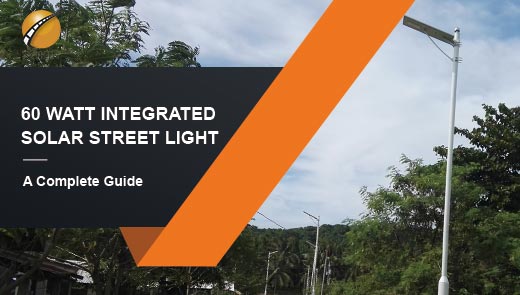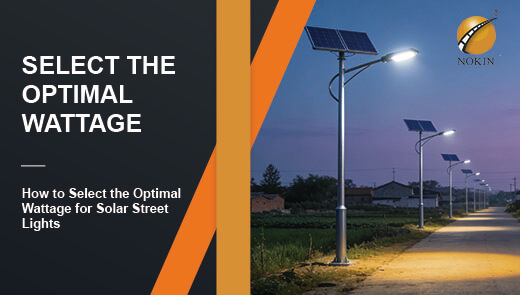Application of Solar Street Lights in Cloudy Areas
Why Should Cloudy Areas Embrace Solar Street Lights?
In many people's impressions, solar technology seems to belong only to sunny areas. But in fact, cloudy, foggy or densely built areas need the changes brought by solar street lights. These areas often face problems such as high cost of traditional power grid coverage and unstable power supply, and solar street lights can solve these problems with their independent operation characteristics.
Take California, which has a diverse climate as an example. It has both sunny deserts and perennially foggy coasts and densely vegetated mountains. The local energy department has long realized that the application of renewable energy cannot be limited to high-sunlight areas. Solar street lights can provide stable lighting even in environments with undesirable lighting conditions through precise design, which is its value.
From an environmental perspective, cloudy areas have a more urgent need for clean energy. These areas are often ecologically sensitive, and reducing dependence on fossil fuels can directly reduce environmental pollution. Public acceptance of solar energy is also increasing, and more and more communities realize that solar energy is still a reliable energy option even in cloudy weather.
Policy-level support makes all this more feasible. Renewable energy incentive programs launched in many regions have reduced the initial investment costs of solar street lights. City managers have gradually discovered that solar street lights can not only reduce long-term electricity bills, but also improve public safety by improving the quality of nighttime lighting, forming a dual return of economic and social value.
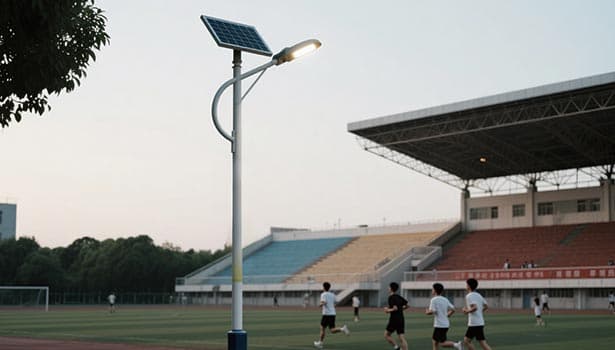
Challenges of Cloudy Environment to Solar Street Lights
"Invisible Loss" of Light Intensity
The most direct impact of cloudy days is a significant drop in light intensity. Data shows that solar radiation in cloudy weather may be only 10%-30% of that in sunny days, and even lower in foggy or rainy weather. This "invisible loss" directly leads to a sharp drop in the power generation of solar panels. If the system is not designed properly, it is easy to have problems such as shortened nighttime lighting time and insufficient brightness.
To make it more complicated, the light on cloudy days is not only low in intensity, but also unstable. The movement of clouds will cause the light to be strong and weak, which is a great test for the energy conversion and storage capacity of the solar energy system. If traditional solar street lights lack the corresponding adjustment mechanism, power supply fluctuations are very likely to occur.
Misunderstood Solar Panel Performance
There is a common misconception about the performance of solar panels on cloudy days: it is believed that solar panels cannot work at all without direct sunlight. In fact, solar panels rely on the photon energy in sunlight, and even scattered light contains a large number of photons.
The real problem is that the design of ordinary solar panels focuses more on absorbing direct light and has a low efficiency in utilizing scattered light. As a result, the actual power generation in cloudy environments may be far lower than the design standard, which in turn affects the reliability of the entire street light system.
The Chain Effect of Long-Term Rainy Weather
Continuous rainy weather for many days will cause more severe challenges. First, dust, raindrops or pollutants may accumulate on the surface of solar panels, further reducing the light transmittance. Second, the battery is in an undercharged state for a long time, which will accelerate aging and shorten the service life.
In this case, it is often difficult to solve the problem by simply increasing the power of solar panels. It requires all-round optimization from system design, equipment selection to operation strategy.
Core Technical Solutions for Solar Street Lights in Cloudy Areas
Choose the Right Panel
Solar panels are the "energy entrance" of the entire system. In cloudy environments, the selection of panels directly determines the power generation. There are currently two main types of panels suitable for cloudy days:
High-efficiency single-crystal panels, with their neat crystal structure, are more stable under low light conditions, and the conversion efficiency can usually reach more than 20%. This type of panel has a strong ability to absorb scattered light, and can maintain a relatively stable output even in cloudy weather.
Double-sided photovoltaic panels are another ideal choice. Both sides can absorb light, and the back can use the reflected light from the ground and walls. In cloudy environments, they can obtain 15%-30% more energy than traditional single-sided panels. With anti-reflective coating, it can also reduce light refraction loss and further improve the utilization rate of scattered light.
Optimization of Solar Street Lights Installation Position and Angle
The optimization of installation position and angle can significantly increase power generation without increasing costs. In cloudy areas, the positioning of solar panels needs to follow the following principles:
First, avoid fixed obstructions such as buildings and trees to ensure that at least 4-6 hours of effective light can be received every day. Second, the installation angle should be adjusted according to the local latitude. It is usually recommended that the angle is equal to the local latitude plus 5°-10° to adapt to the characteristics of the lower solar altitude angle in winter.
For foggy or coastal areas, it is recommended to install the panels at a higher position from the ground to reduce the impact of water vapor condensation and ground dust on the panels. In areas where snow may accumulate, it is also necessary to consider the tilt angle to facilitate the sliding of snow and avoid power generation interruptions caused by long-term coverage.
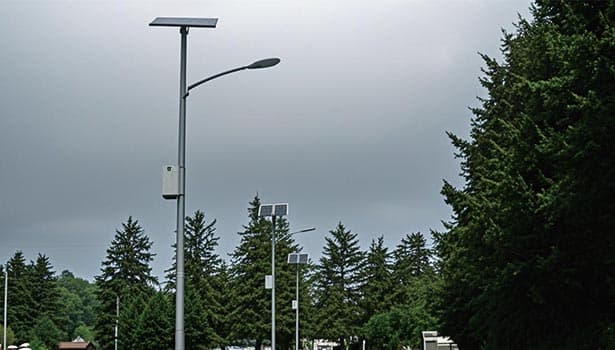
Energy Storage System
Batteries are the "lifeline" of solar street lights on cloudy days, and their performance directly determines the reliability of the system. In areas where cloudy days are frequent, battery selection must meet three core requirements:
High capacity is the basis. It is recommended to choose a battery capacity that can support 3-5 days of continuous cloudy and rainy weather lighting. Calculated as 10 hours of lighting per night, if the street light power is 30W, the battery capacity should not be less than 300Wh (considering a certain redundancy).
Long cycle life is also important. Lithium iron phosphate batteries (LiFePO4) have become the first choice in cloudy areas with a cycle life of more than 2,000 times. Compared with traditional lead-acid batteries, their performance decays more slowly in a deep discharge state, making them more suitable for dealing with frequent undercharging.
Low temperature performance cannot be ignored either. On cold cloudy days, the capacity of ordinary batteries will drop significantly, while batteries with low temperature protection technology can maintain more than 70% of their capacity in a -20℃ environment.
Intelligent Control System
Intelligent control technology is the "nerve center" of solar street lights in cloudy areas, achieving optimal energy distribution through precise control. Its core functions include:
Light sensing adjustment can automatically turn on and off lights according to the ambient brightness, avoiding energy waste caused by turning on too early or turning off too late. In the evening of a cloudy day, the system can sense the dimming of light in advance and start lighting in time; and in the cloudy morning, it can also delay turning off according to the actual brightness.
Motion sensing technology can achieve "on-demand lighting". When pedestrians or vehicles are detected passing by, the brightness is automatically increased to 100%; when no one is present, the brightness is reduced to 30%-50%, greatly reducing energy consumption. This mode is particularly suitable for rural roads or park trails with less traffic.
Adaptive learning function is a more advanced application. By recording long-term light data and power consumption, the system can predict energy supply in the next few days and adjust lighting strategies in advance. For example, when it is predicted that there will be continuous cloudy days, the basic brightness will be automatically reduced to ensure lighting needs during critical periods.
Advanced Strategies to Improve Adaptability to Cloudy Days
Hybrid Energy
For extremely cloudy or foggy areas, solar energy alone may not be able to meet demand. At this time, hybrid energy systems can provide more reliable protection. Common combinations include:
The combination of solar energy and small wind turbines is particularly suitable for coastal or windy areas. Wind energy is often more abundant on cloudy days, and the complementarity of the two can significantly improve the stability of energy supply. The key to this system is to be equipped with an intelligent energy management module to automatically switch the main energy supply.
Moderate connection between solar energy and the grid is another option. After continuous cloudy days, when the battery power is below the threshold, the system automatically switches to grid power supply to avoid lighting interruption. This mode not only retains the environmental advantages of solar energy, but also ensures reliability in extreme situations.
Regular Maintenance
Solar street lights in cloudy areas need more scientific maintenance to maintain optimal performance. Core maintenance work includes:
Panel cleaning is the basis. Although rainwater can wash away some dust, it may also leave mineral deposits, especially in areas with severe air pollution. It is recommended to perform professional cleaning every 1-3 months, which can increase power generation by 10%-20%.
Battery inspection is equally important. Battery performance testing should be performed at least once a year to promptly detect and replace batteries with severe capacity attenuation to avoid affecting the operation of the entire system. In humid areas, the sealing of the battery box must also be checked to prevent water vapor from entering.
The maintenance of the line and controller cannot be ignored. The humidity in cloudy environments is often high, and it is necessary to regularly check whether the line connectors are oxidized and whether the controller heat dissipation is normal to ensure efficient operation of the system.
Optimize System Design
Before deploying solar street lights in cloudy areas, sufficient data analysis can greatly improve the success rate. Specifically:
The collection of local meteorological data is crucial. It is necessary to obtain data such as sunshine duration, cloudy frequency, average radiation intensity, etc. for at least the past three years to provide a basis for equipment selection. For example, in areas where the average number of cloudy days per year exceeds 150 days, higher capacity batteries and more efficient panels must be equipped.
Field lighting tests are also indispensable. Even in the same city, the lighting conditions in different areas may vary significantly. By conducting continuous lighting monitoring at the installation point for 1-2 months, system parameters can be designed more accurately.
The application of simulation software can further optimize the solution. Using photovoltaic system simulation tools, inputting local lighting data and equipment parameters, the power generation and reliability of different solutions can be predicted, so as to select the optimal configuration.
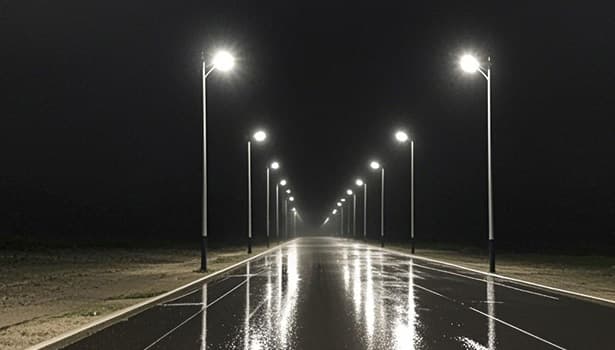
Typical Application of Solar Street Lights in Cloudy Areas
Urban Parks and Waterfront Trails
Urban parks and waterfront trails are often densely vegetated or close to the water, which easily forms a local foggy and cloudy environment. The application advantages of solar street lights here are obvious:
First, there is no need to lay cables, which avoids damage to green spaces and trails and protects the natural landscape. Second, the lighting needs in these areas are obviously time-specific. Intelligent control systems can greatly reduce energy consumption, which is suitable for energy management in cloudy environments.
Taking the coastal trail as an example, solar street lights with double-sided photovoltaic panels and motion sensors can not only increase power generation by reflecting light from the water surface, but also automatically increase brightness when someone passes by, taking into account energy saving and safety.
Rural Roads and Remote Communities
Many rural areas not only have complex lighting conditions, but also face the problem of insufficient grid coverage. Solar street lights have become an ideal choice for these areas:
In mountainous villages, the roads are winding and densely vegetated, and local cloudy days are frequent. At this time, solar street lights with high-capacity batteries and intelligent dimming can maintain basic lighting under unstable lighting conditions, significantly improving road safety.
For remote communities, the independent operation characteristics of solar street lights are particularly important. Even after consecutive cloudy days, the system can still ensure nighttime lighting in the core area and improve the quality of life of residents. At the same time, these areas often have large government subsidies, which can effectively reduce the initial investment.
Temporary Venues and Emergency Lighting
In temporary venues such as large event venues and construction areas, the flexibility advantage of solar street lights is more prominent in cloudy environments:
These venues usually lack stable power grids, and the lighting needs during activities are relatively concentrated. The use of movable solar street lights, equipped with large-capacity batteries and high-efficiency panels, can meet short-term high-intensity lighting needs even on cloudy days.
In emergency rescue scenarios, solar street lights in cloudy environments are even more indispensable. For example, in post-disaster reconstruction areas, solar street lights can be quickly deployed to provide lighting for rescue work and temporary resettlement sites, and are not affected by power grid interruptions.
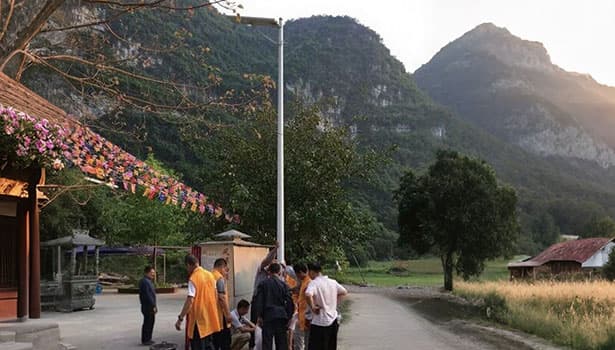
Summary
The application of solar street lights in cloudy areas is essentially a practice of technical adaptation and system optimization. It breaks the inherent perception that "solar energy can only work on sunny days" and proves that through precise design, renewable energy can play its value in a wider environment.
From the selection of high-efficiency panels to the application of intelligent systems, from the supplement of hybrid energy to data-driven optimization, every technological innovation is expanding the applicable boundaries of solar street lights. Today, as environmental protection becomes increasingly important, solar lighting in cloudy areas is not only a technical choice, but also an attitude of sustainable development.

